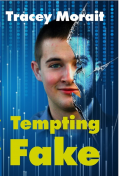
LitPick Review

Tempting Fake by Tracey Morait follows dual protagonists, who both feel isolated from their peers and rely on Pictapost (a popular picture-posting and chat app) to feel connected. However, both teens cope by using Pictapost differently. Behind one side of the screen is Cherry, Helton Manor’s “New Girl”, seeking validation. Her validation comes from creepy fans’ likes, comments, and direct messages on her risky photos and flirtatious captions. The bullied Adam finds himself on the other side of the screen, stalking, sharing, and salivating over Cherry’s page religiously. For some time, they connect through direct messages, but this line of contact falls through once Adam’s phone is confiscated (upon being caught looking at Cherry’s page in class.) His original account is not only hacked by his bully but deleted entirely. At Helton, Cherry begins to branch out and meets her spunky crew of roommates. She begins to uncover the mystery of their previous roommate, Essie's disappearance, and strives to unravel what’s plaguing the shy Tasha. In contrast, Adam internalizes all of his resentment and becomes obsessed with the notion of revenge on his bully, Daniil Petrov, and being with Cherry. This kicks off the disturbing plot of the story as Adam’s revenge mission becomes more and more destructive, and Cherry finds herself falling deeper and deeper into his clutches. How far will things go?
Opinion:
This book was a wild ride. Tempting Fake is truly an attention-holding warning about the twisted realities that lie beyond the internet. No time is wasted before the author, Tracey Morait, draws readers into the story. I was super invested in the plot; it felt as though there was a plot twist at the end of each page. Plot and character writing are the strongest assets in this novel’s arsenal. The characters are all easily distinguished from each other and have their own recurring quirks, which the informal first-person narrations from Adam and Cherry greatly contribute to. These personal narratives also cultivate the reader’s feelings of shock regarding their decisions. That being said, one weakness of the book arises in the ending chapters where a “fade to black” scene is often used to censor something graphic when Cherry and Adam’s perspectives are swapped. However, it hinders reader comprehension of the story slightly, since what occurred in the missing scenes is only vaguely referred to later. This leads the reader to make guesses, and I found myself guessing incorrectly on multiple counts. I believe the scenes were a conscious decision to preserve the “Mature Young Adult” rating of the book and convey Cherry’s horrifying lack of memory while describing the events. However, the events were not later clarified from Adam’s perspective, who would have a full recollection. Minor continuity confusion aside, the ending itself was great: the reveal answers the reader’s final question. It was heartwarming to see the growth of Cherry’s support system and comforting to see where Adam ends up (though I think Cherry’s mother’s suggestions would have been a reasonable end, as well.) I recommend this book to those who enjoy disturbing, thrilling narratives.

